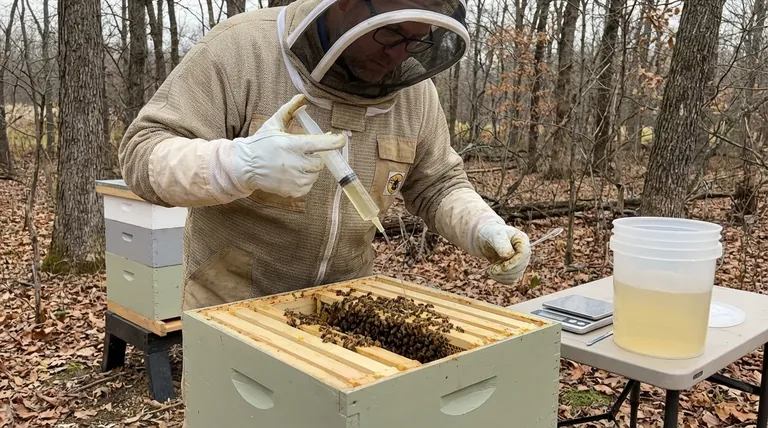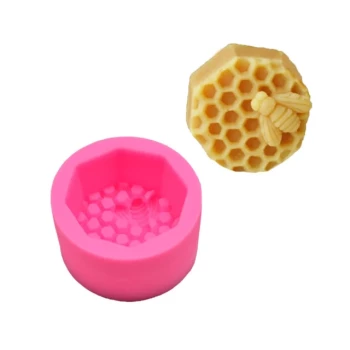In short, the oxalic acid dribble method is a Varroa mite treatment where a solution of oxalic acid and sugar water is trickled directly onto bees clustered between the frames of a hive. This technique uses a large syringe for application and is a direct-contact method for killing mites that are on the bodies of adult bees.
The dribble method is a low-cost, effective treatment for Varroa mites, but its success hinges entirely on one critical factor: timing. Because it is harsh on the bees and only kills mites on adult bees (not in brood), it must be used sparingly and only when the colony is broodless.

How the Dribble Method Works
The dribble method is a straightforward process, but precision is essential for it to be both effective against mites and safe for your bees.
The Solution
The treatment consists of a specific concentration of oxalic acid dihydrate dissolved in a warm 1:1 sugar water solution. The sugar encourages the bees to consume and share the solution throughout the cluster via social feeding (trophallaxis).
The Application
Using a large, needle-less syringe, a beekeeper administers a measured amount of the solution (typically 5ml) into each seam of bees between the frames. The application must be done carefully to ensure the liquid contacts the bees directly.
The total dose is critical and should not exceed 50 ml per colony, regardless of its size. Overdosing can be harmful or fatal to the colony.
The Mechanism of Action
The dribble method works through direct contact. As the solution is dribbled onto the bees, it spreads from bee to bee. Mites on the bees are exposed to the oxalic acid, which is toxic to them, causing them to die and fall off their host.
The Critical Factor: A Broodless Period
Understanding the Varroa mite life cycle is key to understanding why the dribble method has such a specific application window.
Why Timing is Everything
At any given time in a colony with brood, the majority of Varroa mites are not on the adult bees. They are reproducing safely under the capped cells of developing bee pupae.
Oxalic acid, in any form, does not penetrate capped brood. Therefore, it only kills phoretic mites—the ones physically attached to adult bees. Applying it when there is significant brood present will leave the majority of the mite population untouched, rendering the treatment ineffective.
When to Apply
The ideal time for an oxalic acid dribble is during a natural broodless period, which typically occurs in late fall or early winter when the queen stops laying. The bees are in a tight cluster, and virtually all mites are phoretic, making them vulnerable to treatment.
This is why the dribble method is often considered a single, decisive winter treatment.
Dribble vs. Vaporization: A Comparison
The other primary method for applying oxalic acid is vaporization (or sublimation). Understanding the differences is key to choosing the right tool for your apiary.
Application Process
The dribble method requires opening the hive, breaking the propolis seal, and applying the liquid directly to the bee cluster. This is more invasive, especially in cold weather.
Vaporization involves heating oxalic acid crystals in a specialized wand inserted at the hive entrance. The hive remains sealed while the resulting vapor circulates, making it less invasive and faster for treating multiple hives.
Impact on Bees
The dribble method is considered harsher on the bees. The acid solution can damage the bees' sensitive cuticle (exoskeleton) and digestive tract. For this reason, it should only be performed once, or at most twice, per year.
Vaporization is generally considered gentler on the bees. The fine acid crystals that recrystallize inside the hive are effective against mites without the same level of direct, harsh contact on the bees themselves, allowing for multiple treatments if needed.
Equipment and Cost
The dribble method has a very low barrier to entry. It requires only common items like a scale, a syringe, and protective gear.
Vaporization requires a significant upfront investment in a specialized vaporizer tool, which can range from simple, inexpensive models to more robust, professional-grade equipment.
Understanding the Trade-offs and Risks
While effective when used correctly, the dribble method carries specific risks that every beekeeper must manage.
The Risk of Overdosing
The 50 ml maximum dose per colony is an absolute limit. Exceeding this dose, or applying it too frequently, can lead to a significant loss of bees and potentially compromise the entire colony's ability to survive the winter.
Not a "Clean-Up" Treatment
Because it only works in a broodless state, the dribble method cannot be used to "clean up" a high mite infestation during the main beekeeping season (spring and summer) when brood is plentiful. Other treatments are required for in-season mite control.
Unsuitability for Weak Colonies
The harsh nature of the dribble method means it can be particularly stressful for smaller or weaker colonies. Applying it to a colony that is already struggling may do more harm than good.
Making the Right Choice for Your Goal
Your choice of application method should be driven by your specific situation, goals, and management style.
- If your primary focus is low initial cost for a few hives: The dribble method is a viable choice, but only if you can apply it during a confirmed broodless period in late fall or winter.
- If your primary focus is bee safety and treatment flexibility: Vaporization is the superior method as it is gentler on the bees and can be used multiple times if mite counts demand it.
- If you are treating newly acquired package bees: Spraying or dribbling an oxalic acid solution is the standard and highly effective method, as packages are, by definition, broodless.
Ultimately, successful Varroa management relies on using the right treatment at the right time.
Summary Table:
| Aspect | Dribble Method | Vaporization Method |
|---|---|---|
| Application | Liquid dribbled directly onto bees | Vapor circulated inside sealed hive |
| Cost | Low (syringe, scale) | Higher (specialized vaporizer) |
| Impact on Bees | Harsher, can damage cuticle | Gentler, less invasive |
| Ideal Timing | Broodless period (late fall/winter) | Flexible, can be used multiple times |
| Mite Control | Kills phoretic mites on adult bees | Kills mites on bees and in open cells |
Ready to Implement Effective Varroa Mite Control?
Whether you're a commercial apiary or a beekeeping equipment distributor, HONESTBEE has the supplies and expertise to support your mite management strategy. From precision syringes for the dribble method to professional-grade vaporization equipment, we provide wholesale-focused solutions to keep your colonies healthy and productive.
Contact HONESTBEE today to discuss your needs and get the right equipment for your operation.
Visual Guide

Related Products
- Adjustable Formic and Acetic Acid Dispenser for Bee Mite Treatment
- Professional Bamboo Queen Isolation Cage
- Varroa Easy Check Mite Tester Kit Counter Alcohol Wash Jar
- Langstroth Screen Bottom Board for Beekeeping Wholesale
- Metal Queen Bee Excluder for Beekeeping
People Also Ask
- How do Varroa mites spread between honey bee colonies? Stop Mite Transmission in Your Apiary
- What are phoretic mites? A Beekeeper's Guide to Monitoring Varroa Infestation
- What is the optimal time for varroa mite control in nucs? Maximize Efficacy with Perfect Timing
- How can beekeepers ensure their hives survive the winter? A Guide to Colony Survival
- What should be done after treating a colony for varroa mites? A Step-by-Step Guide to Verifying Success



















